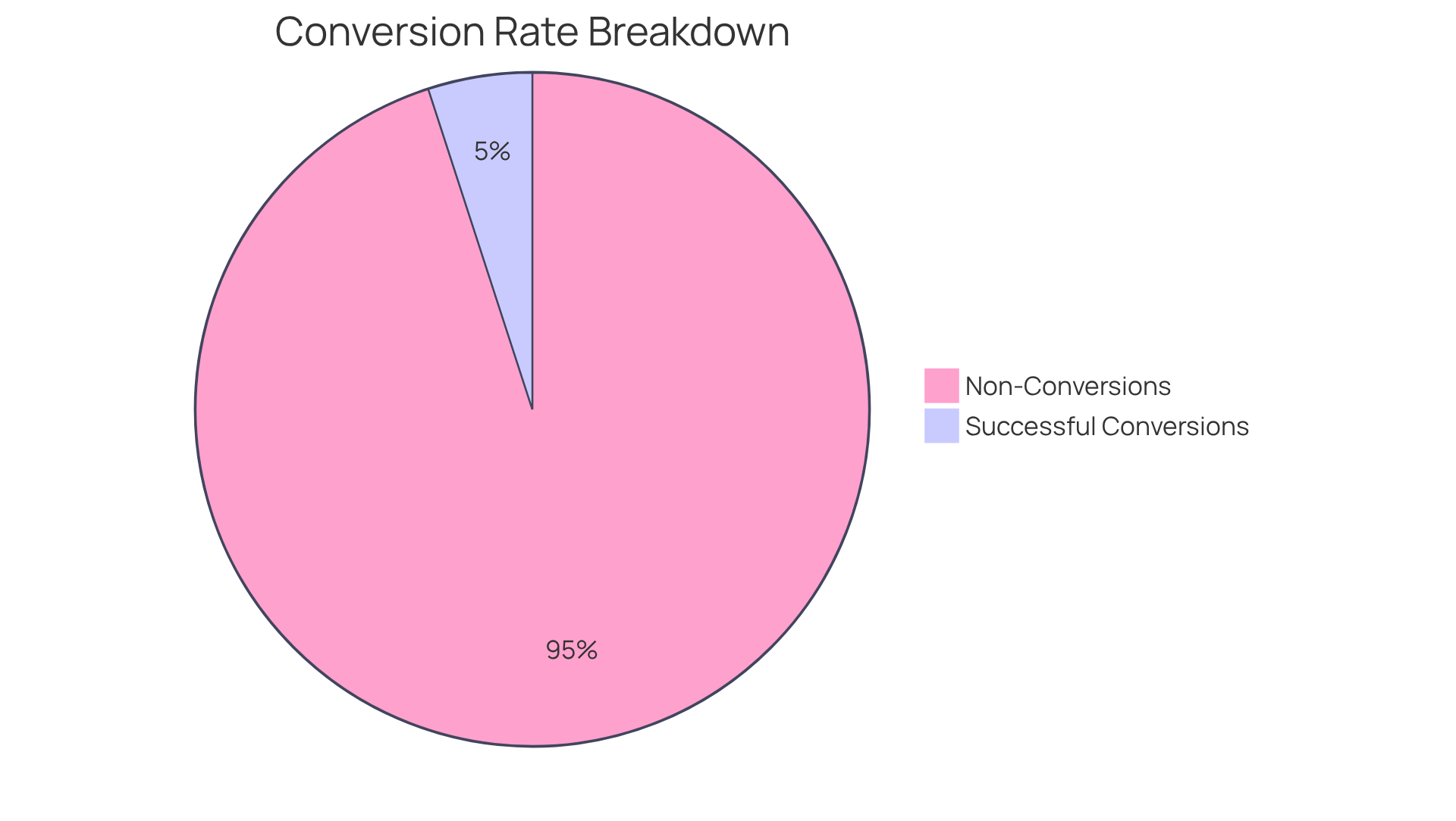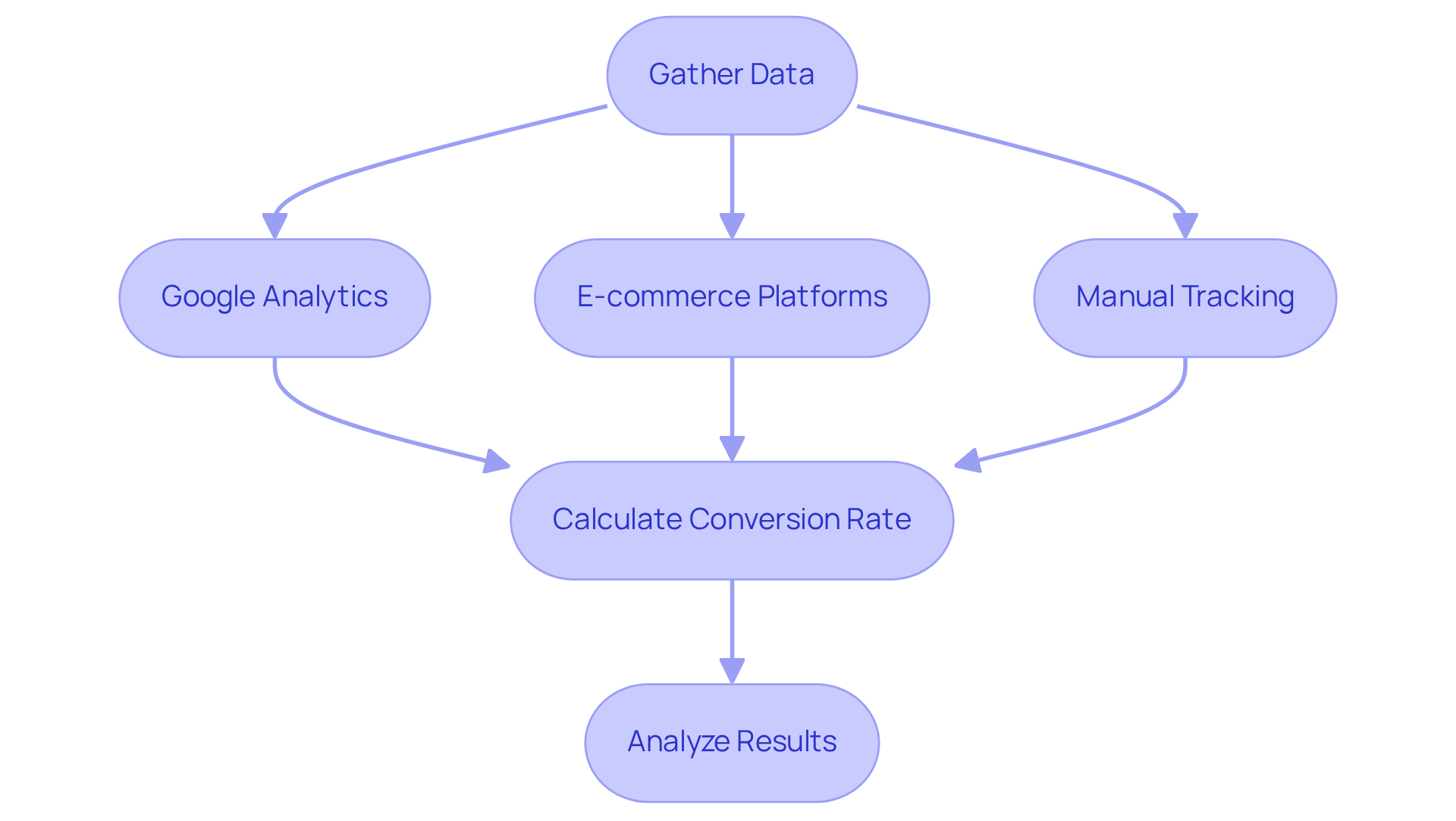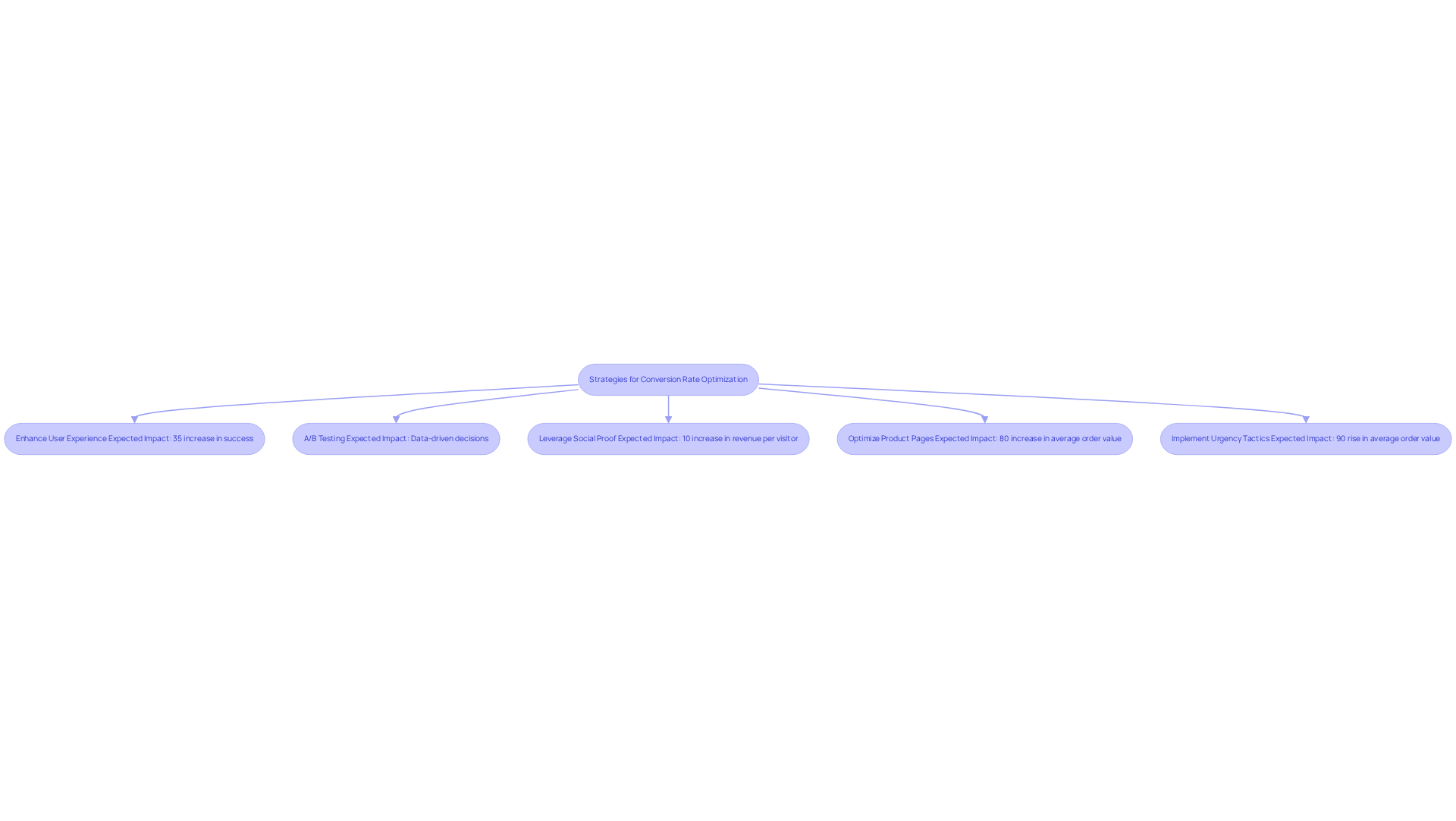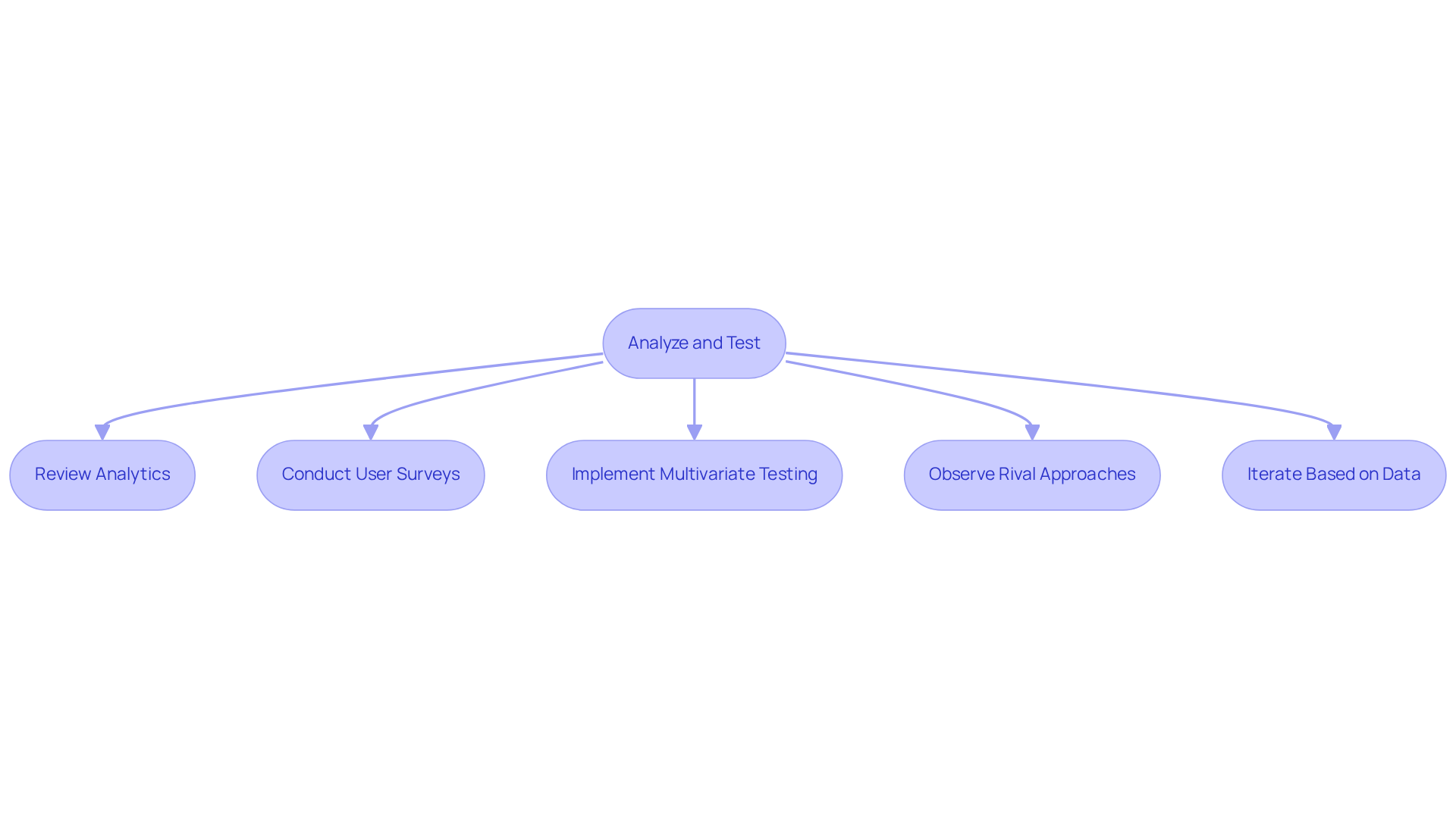
Overview
The conversion rate formula stands as a cornerstone for Direct-to-Consumer (DTC) brands, quantifying the effectiveness of marketing efforts by measuring the percentage of website visitors who complete a desired action, such as making a purchase. Understanding and optimizing conversion rates is not just beneficial; it is essential. Strategies such as:
- Enhancing user experience
- Conducting A/B testing
- Leveraging social proof
are proven methods that can significantly improve profitability and drive growth for DTC companies. By implementing these strategies, brands can transform their approach to marketing, leading to sustainable success.
Introduction
Understanding the conversion rate is vital for Direct-to-Consumer (DTC) brands striving for success in a competitive marketplace. This key metric not only measures how effectively a brand turns visitors into customers but also serves as a linchpin for optimizing marketing strategies and enhancing user experiences. However, many brands grapple with low conversion rates, prompting the essential question: what specific strategies can be employed to transform this challenge into an opportunity for growth? By mastering the conversion rate formula and implementing targeted optimization techniques, DTC brands can unlock their full potential and drive significant revenue increases.
Define Conversion Rate and Its Importance for DTC Brands
The conversion ratio is a critical metric that quantifies the percentage of visitors to a website who successfully complete a desired action, such as making a purchase. This ratio is determined by the :
(Number of Conversions / Total Visitors) x 100
For companies, a higher success percentage signifies and an optimized . Understanding the conversion rate formula is essential, as it not only demonstrates the efficacy of marketing initiatives but also influences and overall profitability.
Consider a DTC brand that attracts 1,000 visitors and achieves 50 successful conversions; the resulting conversion percentage would be 5%. This metric is indispensable for assessing the effectiveness of various and website improvements, establishing its role as a foundational component of any . By focusing on the conversion ratio, businesses can refine their approaches, enhance user engagement, and ultimately drive revenue growth.

Calculate Conversion Rate: Formulas and Methods for DTC Brands
To determine the exchange rate, utilize the :
- Exchange Rate = (Number of Changes / Total Visitors) x 100.
This metric is crucial for aiming to through effective strategies. Understanding the not only captures attention but also establishes the foundation for actionable insights.
There are several methods to gather the necessary data. First,
- Google Analytics offers extensive insights into website traffic and changes in user behavior. By setting up goals, brands can track specific actions, such as purchases or sign-ups, thereby enhancing their analytical capabilities.
Second,
- E-commerce Platforms like Shopify or WooCommerce come equipped with integrated analytics that automatically compute success percentages, streamlining the process.
Lastly, for companies lacking sophisticated analytics,
- Manual Tracking is an option. By manually monitoring the number of visitors and transactions over a specific period, businesses can still derive valuable insights. For instance, if your site attracted 2,000 visitors and achieved 80 sales in a month, your percentage of purchases would be (80 / 2000) x 100 = 4%.
Consistently calculating and tracking the conversion rate formula is essential. It aids companies in recognizing trends and opportunities for enhancement, ensuring that paid advertisements and landing pages are smoothly coordinated for substantial growth. By implementing these strategies, DTC brands can effectively leverage data to refine their approaches and drive profitability.

Implement Strategies for Conversion Rate Optimization in DTC Brands
To optimize conversion rates, can implement several effective strategies:
- : A user-friendly website with intuitive navigation and fast loading times is crucial. Studies indicate that are a prevalent issue impacting mobile optimization, leading to increased bounce rates. A seamless experience not only reduces these figures but also encourages purchases, ultimately enhancing . For instance, a $30M clothing brand that revamped its homepage to emphasize social proof and testimonials experienced a 35% increase in success.
- : Regularly testing different elements of your website—such as call-to-action buttons, product images, and checkout processes—can yield significant insights. A/B testing is essential for identifying what resonates best with your audience, enabling data-driven decisions that enhance user engagement and apply the . Continuous testing fosters ongoing improvement in advertising results, as noted by industry experts.
- : Displaying prominently on product pages builds trust and can significantly influence purchasing decisions. This approach aligns with the understanding that effective marketing feels genuine and emphasizes providing value, which is essential for long-term customer relationships. The aforementioned clothing label's strategy of showcasing reviews contributed to a 10% increase in revenue per visitor.
- : High-quality images, detailed descriptions, and clear pricing enhance product appeal. A well-designed product page not only attracts attention but also builds credibility, which is vital for converting visitors into customers. For instance, Grab Green, a $15M revenue cleaning product line, improved its average order value (AOV) by 80% through optimized product presentations and strategic pricing.
- : Utilizing countdown timers or limited-time offers creates a sense of urgency that encourages customers to complete their purchases. This strategy can effectively boost results by prompting immediate action. STRNG Seeds, a rapidly expanding DTC cannabis company, applied urgency tactics and experienced a 90% rise in AOV.
By implementing these methods, DTC companies can efficiently enhance their success metrics and boost sales, ultimately optimizing their return on investment. For instance, EmberTribe's collaboration with Qeepsake resulted in a 200% increase in ad budget while decreasing the unit cost for each additional sign-up, illustrating the potential outcomes of these strategies.

Analyze and Test: Continuous Improvement for Conversion Rates
To ensure ongoing enhancement in success metrics, must adopt a to examination and experimentation.
- Regularly Review Analytics: Leverage tools like Google Analytics to monitor traffic sources, , and success rates. This practice allows for the identification of patterns and areas requiring improvement.
- Conduct User Surveys: Directly gather feedback from customers regarding their shopping experiences. Such insights can illuminate pain points and opportunities for enhancement.
- Implement : Moving beyond A/B testing, multivariate testing enables companies to evaluate multiple variables simultaneously, providing deeper insights into which combinations yield the best outcomes.
- Observe Rival Approaches: Analyze competitors’ strategies for and adapt effective techniques to your own brand.
- Iterate Based on Data: Utilize the insights derived from testing and analysis to inform decisions about website modifications and marketing strategies.
By fostering a culture of , DTC brands can adeptly respond to market changes and consistently enhance their .

Conclusion
Mastering the conversion rate formula is crucial for the success of Direct-to-Consumer (DTC) brands. Understanding and effectively utilizing this metric enables businesses to gauge the effectiveness of their marketing strategies, enhance user experience, and drive profitability. The conversion rate is a vital indicator of how well a brand converts visitors into customers, making it an essential component of any growth strategy.
In this article, we shared key insights on calculating and optimizing conversion rates. Utilizing tools like Google Analytics, implementing strategies such as A/B testing, and enhancing user experience are all methods that contribute to refining the conversion process. The importance of social proof, urgency tactics, and continuous analysis cannot be overstated, as these elements significantly impact success metrics and boost sales.
Ultimately, the journey to optimizing conversion rates is an ongoing process that demands dedication and adaptability. DTC brands must embrace a culture of continuous improvement, leveraging data-driven insights to remain competitive. By prioritizing conversion rate optimization, brands can achieve sustainable growth and ensure long-term success in the dynamic e-commerce landscape.
Frequently Asked Questions
What is the conversion rate?
The conversion rate is a metric that quantifies the percentage of visitors to a website who successfully complete a desired action, such as making a purchase.
How is the conversion rate calculated?
The conversion rate is calculated using the formula: (Number of Conversions / Total Visitors) x 100.
Why is the conversion rate important for Direct-to-Consumer (DTC) brands?
For DTC brands, a higher conversion rate indicates effective marketing strategies and an optimized user experience, which are crucial for customer acquisition costs and overall profitability.
Can you provide an example of calculating the conversion rate?
If a DTC brand attracts 1,000 visitors and achieves 50 successful conversions, the conversion rate would be (50 / 1000) x 100, resulting in a 5% conversion rate.
How does the conversion rate impact marketing campaigns?
The conversion rate is essential for assessing the effectiveness of various marketing campaigns and website improvements, making it a foundational component of any growth strategy.
What can businesses do to improve their conversion rate?
By focusing on the conversion rate, businesses can refine their marketing approaches, enhance user engagement, and ultimately drive revenue growth.
FAQs











